Category Archives: All UkulelePlay! Blog Posts
Ukulele Questions: “Any one who finds it difficult to memorize chords and lyrics have any tricks in addition to repetition?”
Today’s question comes courtesy of Phil Gerace posting in the Ukulele Players (Uke Players) group on Facebook. This is an issue that haunts more than just ukulele players, but musicians in general. Some seem to have an easy time with memorization and others just struggle, and struggle some more.
I used to try to rely on mindless repetition to get things memorized. Back in the day when I was playing a song instrumentally, OR singing it while being accompanied by a pianist or orchestra, this worked OK (never great, but OK). However, when I started trying to memorize songs that I had to sing and play at the same time, this method of memorization broke down for me and just did not work at all.
My problem stems from the fact that the brain is remarkably efficient. Why should it expend energy creating pathways in the brain to ‘memorize’ a song when you always have that sheet music handy in front of you? At least in my case, it won’t do it, because it doesn’t need to. As long as that sheet music is handy, it says, ‘Don’t ask me. Look at the sheet music.”
This is THE main reason I have become disillusioned with my ‘classical’ training over the past few years, which was heavily focused on the reading and interpretation of sheet music. I don’t blame my teachers or the musical establishment, but I do wish I could have found some help in thinking differently about this years and years ago.
I’ve made a lot of progress on this in the last year through reading up on the subject (I wish I could cite all the people I’m indebted to for their thoughts on this, but I don’t think I could trace them all down) and trying to apply a little bit of reason to my meditations on the subject. As a result, I made up a first draft of a Memorization Bingo which included a lot of different ways to break down a song and really look at it from the inside out. Now this is where all my classical training did help me out tremendously, as many of the things I put on my bingo sheet involved music theory and solfa/solfeggio (sight reading) training.
In the first version I had a number of tasks that involved drawing out the lyrics in picture form. However, I did not find that helpful (for me), so I cut the bingo card down from a 5 x 5 grid to a 4 x 4 grid to make a version 2.0. This cut me down 9 full squares, but I figured if I was not memorized by the time I finished the 16 squares I could do the bingo all over again, or make additional marks on squares I felt I needed more help on.
Memorization Bingo 2.0
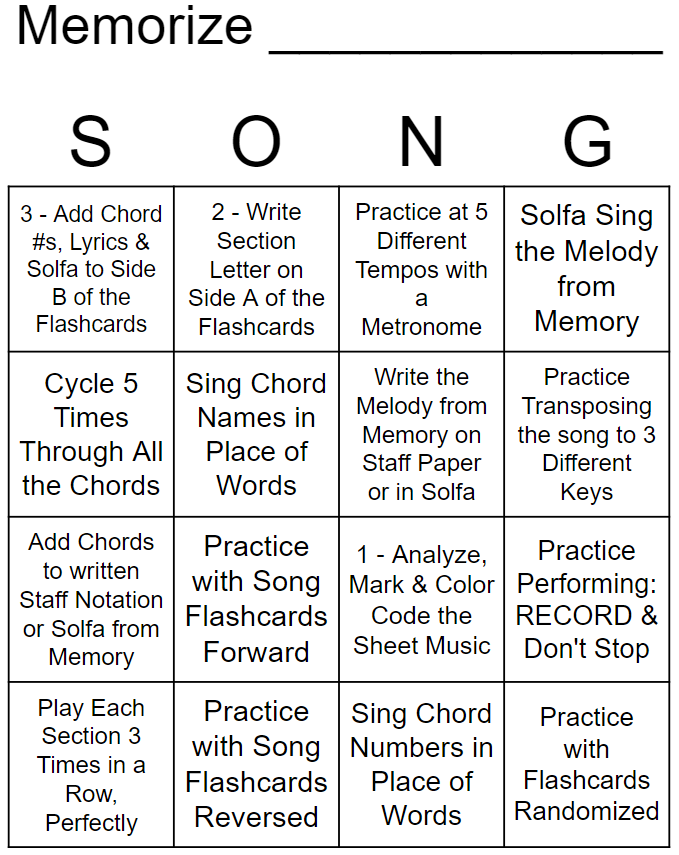
You can edit this and generate your own card at https://bingobaker.com/view/3226564. I think some of the squares might need a little explanation, so below is a list of all sixteen items and a brief overview of each. The ones with numbers before them are meant to be done in a sequence. The rest of the items don’t necessarily need to be in a certain order, but some orders make more sense than others.
- 1 – Analyze, Mark & Color Code the Sheet Music : I usually start with sheet music and make sure to feel comfortable playing the song before I start memorizing. During this step I can mark anything on the sheet music I want to remember, separate it into logical sections and phrases (giving them rehearsal numbers/letters or section letters according to the form of the song), analyze the chord progression and add splashes of color for emphasis. This lays the groundwork for all the other things I’m going to do.
- 2 – Write Section Letter on Side A of the Flashcards : Now I’ve done the tough work of making a note of everything I think is important in the song and breaking down its structure I can start on my flashcards by putting a rehearsal letter/number or form letter on one side of my cards.
- 3 – Add Chord #s, Lyrics & Solfa to Side B of the Flashcards : Now I flip the cards over and add 3 lines of information. I start with the lyrics. Above the lyrics I put the chord numbers (NOT the chord names, but the numbers I’ve gotten from analyzing the chord progression – this will be important to me later as I try to transpose the song to other keys). Then under the lyrics I write out the solfa letters as a reminder of the what the melody is like; for a melody that went Do Do Sol Sol La La Sol (Twinkle, Twinkle Little Star) I would just write out D D S S L L S.
- Write the Melody from Memory on Staff Paper or in Solfa
- Add Chords to written Staff Notation or Solfa from Memory : I’d save this one for after the one above, but you don’t have to.
- Cycle 5 Times Through All the Chords
- Play Each Section 3 Times in a Row Perfectly
- Practice with Song Flashcards Forward
- Practice with Song Flashcards Reversed
- Practice with Flashcards Randomized
- Sing Chord Numbers in Place of Words : Helps to cement the chord progression and prepare you to transpose the song.
- Solfa Sing the Melody from Memory : Sing it with your Do Re Mi.
- Sing Chord Names in Place of Words
- Practice at 5 Different Tempos with a Metronome : Practicing at different tempos is a great test to see if you’re ready to play the song with others, as tempos often shift in group performances from what you’re used to.
- Practice Transposing the song to 3 Different Keys : This is where practicing with the chord numbers will really come in handy. I think transposing a song to a different key, even if you never plan to do this in performance, is just a good brain exercise to get that song in there firmly.
- Practice Performing: RECORD & Don’t Stop : I do this one last as a test to see if I needed to do anything more.
Honestly, on the last song I tried this out on, I was memorized long before I got through the entire list. I still think it is an excellent way to make sure that song is so firmly cemented in your brain that you’d have a hard time messing it up, even in the most high-pressure performance situations.
Anyway, I hope that’s helpful. Feel free to modify and adapt as you will. Uke on!
Ukulele Questions: What are the Ukulele Sizes?
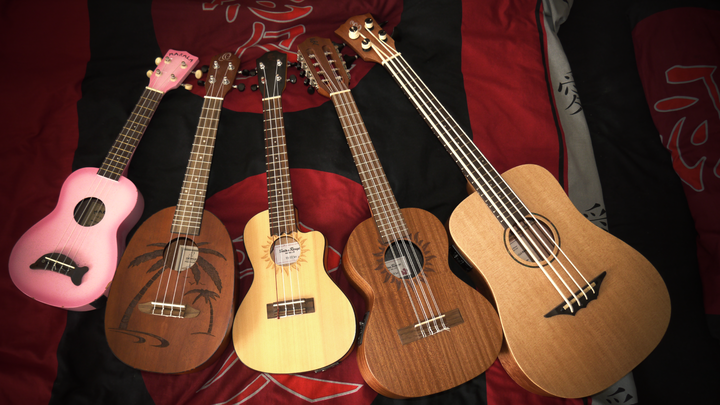
There are four standard sizes of ukulele:
- Soprano : The ‘original’ ukulele size with a ‘scale-length’ (the distance between the nut and the saddle) of 13 inches. I’ve heard it argued that this size of ukulele is the only ‘true’ ukulele. That of course depends on your definition of what makes a ukulele a ukulele. I’ll talk about that in a future post.
- Concert (more common) or Alto (rarely used) : An innovation of the roaring twenties when the ukulele was all the rage. Vaudeville performers, desiring a ukulele with a little more projective power for stage use, added two inches to the ukulele to give it a 15-inch scale length.
- Tenor : Later on, someone added another two inches, for a 17-inch scale length, and dubbed the instrument a ‘tenor.’ Tenor’s have the most projective power of the three and a deeper ‘bass’ response (which means the lower notes have a fuller tone). With extra length often comes more frets, which means you can play higher.
- Baritone : Someone in the 1940s added yet another two inches, for a 19-inch scale length, AND tuned the strings down a 4th to DGBE, the same as the top four strings of a guitar, and decided to call it a Baritone.
Soprano, Concert & Tenor ukuleles all usually tune to gCEA (reentrant) or GCEA (linear or low-G); therefore they can all play from the same chord charts, music, tabs and books that are printed for the ukulele. For the Baritone ukulele you will use different chord charts and there is not a ton of music or tabs for the instrument; however, it is easy to adapt Guitar music, which is abundant, by ignoring the missing E and A bass strings.
If you want to go really small, there are pocket and sopranino ukuleles out there.
If you’re a bass lover, ukulele basses abound; however these are really just ultra-short-scale basses that are tuned exactly like a bass guitar (their main advantages being portability and ease of play).
If you’d like to read more about this subject, the wikipedia article on ukuleles is pretty thorough.
It has been asked, ‘Which size of ukulele is the best?” To which the quick answer is … The one you like the best. However, I will go into some of the strengths and weaknesses of each of the instruments in a future post – all of them have their good points and I own at least one of each size.
Ukulele Questions: “Why is the E chord such a pain in the neck to play? 😠”

Today’s question and a boatload of advice come today from Graham Shaw posting in the Ukulele Tabs and Uke Stuff group on Facebook. Sigh … the E chord. What can I say? There seems to be no end of advice on how to play it, yet people still struggle with it.
My advice: Don’t bother playing the E Chord in root position (4442). I’ve been playing for ten years and I’ve never once ‘needed’ to play it in this position. I usually choose to play the barred version of E (4447), which not only is easier to play, but sounds much better (as the root of the chord is doubled rather than the fifth).
This advice also extends to the D chord, most of the time. I prefer to play the barred 2225 version of the chord, rather than the 2220 version for the same reason as above. Doubling the fifth of a chord makes it sound unbalanced and top heavy. Doubling the root makes the chord sound more ‘rooted’ and fuller.
Skip the stress and barre these chords.
Addendum … Here are a couple of replies I fielded to objections to my oversimplification above.
This is part of the beauty of music. Many will gleefully agree with you; however, there are others who might question your approach. Some of us have even played longer than ten years.
Yes, its great to be able to agree to disagree, but I’d be careful about discounting someone’s experience just because they haven’t played a particular instrument as long as you. I’ve actually been in music my entire life, my father was a band director, I play many instruments, I got my degrees in vocal performance and music composition. When I talk about the doubling of the root as opposed to the fifth, this is backed up by five hundred years of common practice theory. A root doubling is more stable sounding than a chord that is doubled at the fifth. This is one of the reasons that the ukulele often sounds more awesome playing 7th and and 9th chords, not only do those add extra color, but avoid the problems of doubling the third and fifth of chords (doubling the third is the most problematic of the three).
Sorry I have to nit pick at one point here. There is no chord position that always sounds better, it depends what is being played around it. Sometimes one will sound better and sometimes another, and sometimes the only way to make a fast transition is to use a different chord position than usual. When composing, variation can be attained by repeating similar song segments with different chord positions. Sure you can get by with only one if you like but in doing so one should be aware and consider that you are undoubtedly limiting yourself and some songs aren’t going to sound quite right.
I should have mentioned that I was talking about strumming/fingerpicking to accompany oneself while singing – in which case I still think the barred versions of E and D sound better, they are more balanced to my ears … of course additional inversions are also good if you are playing up the neck.
If you start talking about ‘composing’ for the ukulele, of course, no one position is going to do all things for all songs, but at that point, once you’re really writing music for the ukulele, there’s nothing that says you have to be using all four strings at the same time and your options open up exponentially.
Ukulele Questions: Can Ukulele Strings Break?
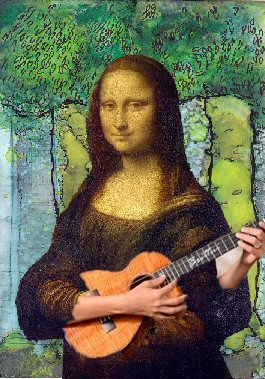
They can, and I’ve seen it happen, but they are usually not as prone to breakage as they are on a steel string instruments, such as the guitar or mandolin. What are some things that could cause your strings to break?
- Over-tightened strings: Not only can winding your strings too tight break your strings, but it can cause damage to your bridge and even pull it off. It is usually safe to tune a standard ukulele up a whole step from GCEA tuning to ADF#B (which is the standard tuning in certain parts of the world), but go much higher and you’re putting your ukulele in peril (especially concert and tenor-sized instruments).
- Old strings: The materials strings are made of can become brittle with age (nylon, plastic, fluorocarbon, etc.). That said, there are ukes out there that are happily played and yet have never had their strings changed. Whether this is good or bad is a personal call. However, fresh strings are far less likely to break, and you don’t want to try to settle in a new string mid-performance.
- Nicks in the strings: Nicks from collisions with the objects of everyday life and being pressed against the fret wires could be the source of a break, but over-tightened or old strings are more likely culprits (unless you go banging your uke about a lot, traveling with it out of its case, leaving it in the car in the heat, etc.).
Some people are fanatical about changing their strings regularly. They like the sound of ‘fresh’ strings. For me, if you feel underneath the strings and notice deep grooves where the fret wires make contact with the strings, then it is probably a good idea to change them out. Worn strings can do more than break, they can cause intonation issues that will make you sound out of tune, or become dull and lifeless sounding.
If you’re in the market for new strings, I’ve really been enjoying Aquila’s Sugar Strings on my carbon fiber tenor ukulele. I am also a fan of fluorocarbon strings of all stripes (they’re all the same material) and have a set on my Godin multiuke.
AXEL F – Uke & Me goes Back to the 80s
Ukulele & bass cover … sheet music at http://ukuleleplay.com/for-ukulele-en… … support further creative work and get patron extras at http://patreon.com/uke … Thanks for listening!!!
Ukulele Questions: Types of Ukulele Straps
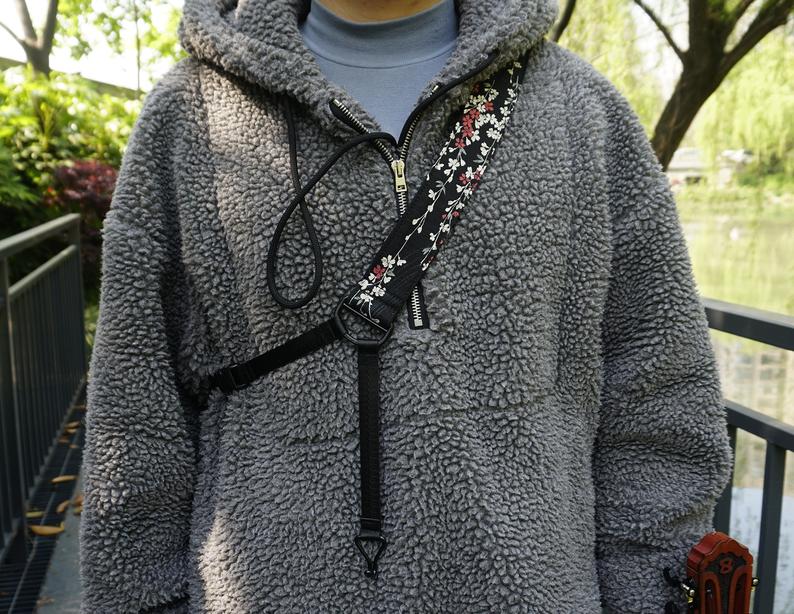
A couple of days ago I got this question from one of my readers: “Can you please identify the different types of straps available and the pros/cons of each.” To which I say, “Absolutely.”
One might think, ‘A strap is a strap is a strap,’ but that’s not strictly true. People have devised a multitude of ways to attach instruments to their bodies.
Kinds of Straps : a Partial List
- You can find a standard ‘guitar-style’ strap at any music store. These are usually rather wide for ukuleles (a small and light instrument). If you can find this style of strap with a narrow width, like this 1-inch wide strap, they are great. They do require you to have two strap buttons installed on your ukulele, but they hold your instrument securely to your body and it is easy to use your hands when teaching, talking, expressing to your audience and even allow you to swing the instrument around to your back when walking to and fro. My own paracord ukulele strap design is basically a standard strap made of paracord.
- Some people take a standard strap and put a shoe-string through one of the end holes to tie under the strings above the nut. This means you only have to install one strap button at the base of the lower bout. I am not personally fond of having one of the anchor points above the nut, as to me it partially defeats the purpose of having a strap at all. With this configuration you will still have to juggle your instrument a bit as it tries to move toward the ground under the force of gravity.
- The extra-long boot lace is another option for a lot of do-it-yourself folk. You tie one end around the waist of the ukulele (doesn’t work with pineapple-style ukes) and the other above the nut. I’m not a fan for the same reason above; this is still a juggler’s solution.
- The classical-style strap is basically a lanyard with a j-hook on the end which hooks into your sound hole. For someone not wanting to add strap buttons to their ukulele, I think this is a fantastic option and have used them with my Ukulele Youth group. Jake Shimabukuro sells his own variation on this design that will set you back the cost of a cheap ukulele. One of the key advantages of the classical design is that you get support for your instrument in a well-balanced location, but the instrument is not held rigidly against your body. There’s plenty of opportunity with one of these straps to get the most out of your instrument’s natural acoustics. The reason I do not use one of these myself is that you have to keep your hands on your ukulele. If you let go, the uke will flip over, fall off the hook and tumble to the ground. As a teacher, this is not practical for me.
These seem to me to be the main categories of strap, but other strap designs are abundantly available.
- The Hug Strap is a fancy, much prettier version of the bootlace.
- The Uke Leash is another, minimalist variant of the bootlace with a twist.
- 4uke J-hook Strap is one of the coolest hybrid designs I’ve seen. It’s a classical strap that looks like a traditional strap. I love that you don’t have to put it around your neck.
- DIY options abound as well. Just search for ‘DIY Ukulele Strap‘ and you’ll come up with tons of options (mostly based on similar design ideas).
Whether you choose to use a strap or go strapless, hopefully that will give you a better idea of some of the options available out there. If you come across a really cool and unique strap design out there, please let me know by leaving a comment … I’d love to feature it in the future.
Ukulele Questions: Should I wear a strap?
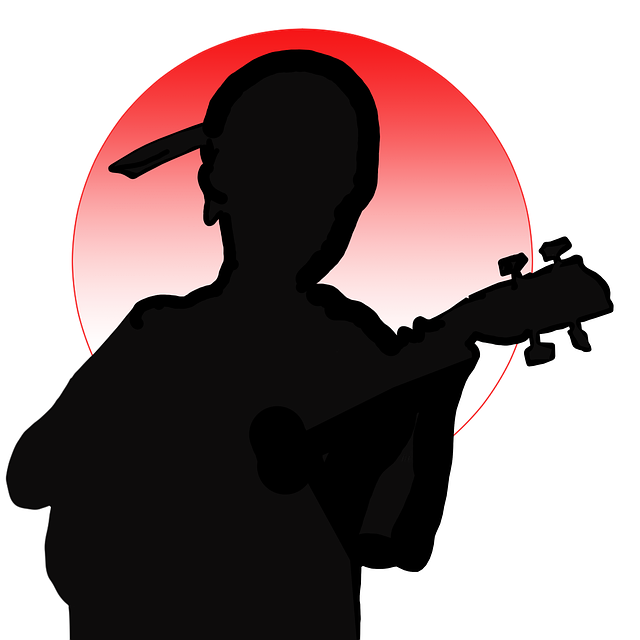
Whether to wear a strap or not is totally a personal question you’ll need to answer based on your needs, preferences and desire for bragging rights. As I’ve mentioned before, there are some who are very proud that they do not wear a strap, while others are big advocates for straps (like me). I’d like to address some of the advantages and disadvantages of being strapped or strapless (in regards to your ukulele), at least as I see it.
Wearing a Strap
- Advantage: You don’t have to worry about juggling your instrument and making sure it doesn’t fall out of your hands. This is especially handy for beginners, who have enough to worry about with fretting, strumming, fingerpicking, learning to read music/tablature and often trying to sing at the same time. The juggling aspect of going strapless really ups the difficulty of all these other things.
- Advantage: You’ll never worry about dropping your uke. This is especially handy for me as a teacher, because it means I don’t have to set my uke down every time I need to adjust a student’s hand position or write on the whiteboard. It doesn’t just apply to teachers though … I’ve seen ukes dropped on many an occasion; it’s painful to watch.
- Advantage: You can position the ukulele on your body in a lot of different ways. This allows you to get a better position for your wrist health and/or body type. Most woman who are not flat-chested are particularly glad for the ability to find a comfortable position for their ukulele that doesn’t require some kind of Twelfth Night wrapping up of their chest.
- Advantage: Standing or sitting, the strap keeps your ukulele in the same position. It’s amazing how a change in ukulele position can all of a sudden make your familiar instrument feel unfamiliar.
- Disadvantage: You may have to endure the almost self-righteous determination of strapless ukulele players to convince you you’re doing it wrong.
- Disadvantage: It has been argued that strapping your ukulele to your body may dampen the instrument’s natural acoustics and muffle its sound. This can be a valid point. The ukulele is already notoriously quiet. However … I think with time and experience you can learn to offset this if you find it to be a problem.
- Disadvantage: You may have to drill into your ukulele to install strap buttons if that is the kind of strap you are going to use. Though there are straps that do not require buttons to hold your uke, I have never noticed a change in acoustics in the instrument when installing strap buttons … they are my preferred way to go.
Going Strapless
- Advantage: Bragging rights that you are doing it the ‘traditional’ way. You can then lord your superiority over other ukulele players and alienate yourself from them.
- Advantage: No drilling required. For some people that have invested in an expensive ukulele, this is a real issue. Once again though, as long as you’ve got a wood block at the base of your lower bout (check with a flashlight inside the sound hole), you should have no problem installing a strap button. The difference is only cosmetic.
- Advantage: You may experience a boost in acoustics (tone and projection), but this depends largely on how well you hold your ukulele. If you really want to get the absolute most sound out of your instrument though, you should consider playing seated with your ukulele resting on your leg a little tiny way away from your body, as classical guitarists do. I find this impractical for performance though (see my last post).
In Favor of Straps – Famous Players that Use Them
I’m not going to make an exhaustive list, but here are a few that spring to mind:
- Jake Shimabukuro – the most famous ukulele player in the world uses a strap
- Taimane Gardner – who also demonstrates that you can hang your ukulele much lower if you want to use flamenco techniques in your playing
- Sarah Maisel – one half of the ukulele world’s sweetheart couple, and a fantastic jazz player, uses one
Now I have to mention the BIG exceptions here … James Hill is a huge proponent of going strapless as are most of the traditional Hawaiian artists (its part of the culture).
So? Should you use a strap or not? That’s a decision for you to make, but I hope I’ve given you some things that might better inform your decision.
Next time I’ll address the different kinds of ukulele straps out there. Meanwhile … Happy strumming! 🙂
Ukulele Questions: Stand or Sit?
Another question from one of the FB groups I belong to … “Do you prefer standing or sitting while playing?”

I prefer sitting, but I make myself practice standing a lot of the time, because that’s how I perform and teach most of the time. There’s nothing more disconcerting than to try to do a performance in a position that is completely foreign to the way you’ve practiced. If I never performed or taught, I’d probably always sit while when playing.
So if you plan to go to open mics or perform, I’d suggest spending some time practicing standing. I would argue that a standing performer has an easier time engaging the audience over the course of a set.
Also relevant to this question: Do you use a strap when standing? … I love my straps. Some people wear ‘I don’t use a strap’ like a badge of honor, but the audience doesn’t care if you’re juggling your ukulele or using a strap as long as the music’s good.
Ukulele Questions: Can Ukuleles Play Sad Songs?
Yes, it has been asked! Can you play a sad song on the ukulele? Short answer: YES! As Elton John famously penned, “Turn ’em on, turn ’em on, Turn on those sad songs, When all hope is gone … Sad songs say so much.”
To leave the sad songs out of our repertoire would mean leaving out a much relieving and therapeutic aspect of playing and performing music … The ability to turn our frustrations into art … to sing the blues.
Eddie Vedder said of the ukulele, ” “It is a happy sound, and by using it to process some emotions that were less than joyful, it somehow balanced it out to where it didn’t sound like suicide music.”
Ukuleles have been helping people sing sad songs since the first wave of ukulele popularity in 1915 …
So if you feel like singing about the end of the world, get it out of your system …
What does one get for the $4 level? at Patreon.com/Uke
I recently was asked, “What does one get for the $4 level?” in reference to what I offer people at Patreon.com/Uke. I thought others might have the same question, so I put together this post.
I currently have two tiers for membership at Patreon.com/Uke, Distance Learners and Song of the Month Club (pre-pandemic, I also had a level for live instruction, but have had to put that on hold).
The Distance Learners level already includes a huge amount of content you can gain access to and I’m adding new material every month. Already published material includes:
- Send Ryan questions, comments and requests via the patron-only news feed.
- Access to basic versions of Song of the Month Videos.
- Access to public and unlisted videos (tutorials, play-alongs, music videos), PDFs of music, informational & instructional blog posts on a wide variety of ukulele subjects on UkulelePlay.com.
- Access to a number of my books in PDF format. This currently includes 96 American Spirituals, Two Chord Camp Songs and the 2-Chord Christmas Songbook.
- Video Tutorials for for all the Camp Songs as well as a number of the Spirituals.
- Easy strummer video class archive.
- Archive video of many Happy Valley Ukes live rehearsals.
- Updates on ukulele articles, performance videos, blog posts and fun finds.
- New content every month.
In addition, Song of the Month Club members get:
- Additional tutorials on the Song of the Month, including alternate chords, fingerpicking, strumming and instrumental tablature.
- Greater pull in choosing future Song of the Month Club selections.
- Invitation to participate in Song of the Month performance videos.
Hope that is helpful. Visit Patreon.com/Uke and choose the level that’s right for you.
Should I use an effects pedal with my ukulele bass?
I’m a member of the UBass Freaks group on Facebook and recently someone asked, “… is anyone using pedals with their bass and what is the benefit or attraction?”
Let’s start with the problems of basses in general and ukulele basses in particular. Depending on what kind of short-scale bass you have, you’re likely to run into different problems. I have two custom short-scale basses … neither a branded UBass, but I’ve played those as well and am familiar with the issues. These can include:
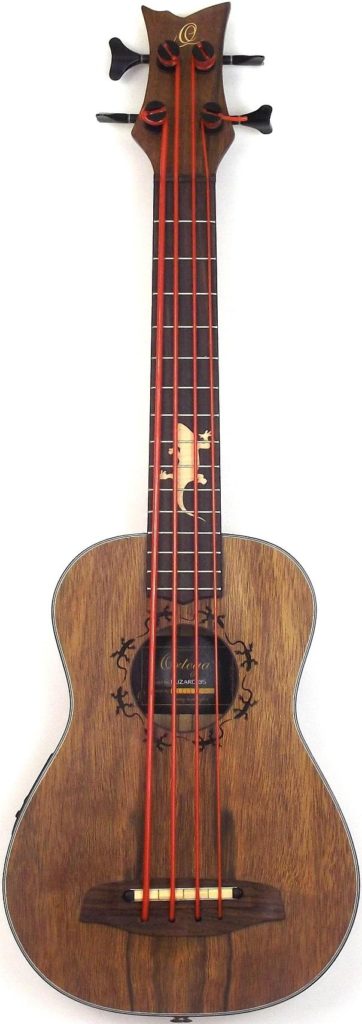
- Lack of presence … short-scale basses, and UBass models with the giant polyurethane strings in particular, can lack presence and be ‘boomy.’ Effects pedals can help tailor the sound of your bass through equalization so that it is actually heard, and not just felt.
- Lack of interest … the basic bass sound, without some kind of gain/boost, drive, and/or compression can be pretty underwhelming, especially with passive pickup systems that really require a huge boost just to be heard. Besides fixing these problems, pedals can add additional interest for certain styles of music with distortion, fuzz, octave doubling, synths and a host of other interesting sounds.
- Basses with metallic strings of any kind can conjure up a lot of fret noise. Also, many of the above mentioned effects add to the ‘noise floor’ of an amplified bass, even when not being played … There are pedals that specialize in dampening extra noise.
What do I use?
- The Zoom B3 (which emulates many pedals) is great for fuzz, distortion and experimenting with sounds.
- I also use a SansAmp Bass Driver (for more basic sounds with my piezo pickup bass) paired with the Decimator II (for noise threshold control).
Some other suggestions from forum members include:
Ukulele Questions: Is it cheating to use TABs?
The short answer is: NO.
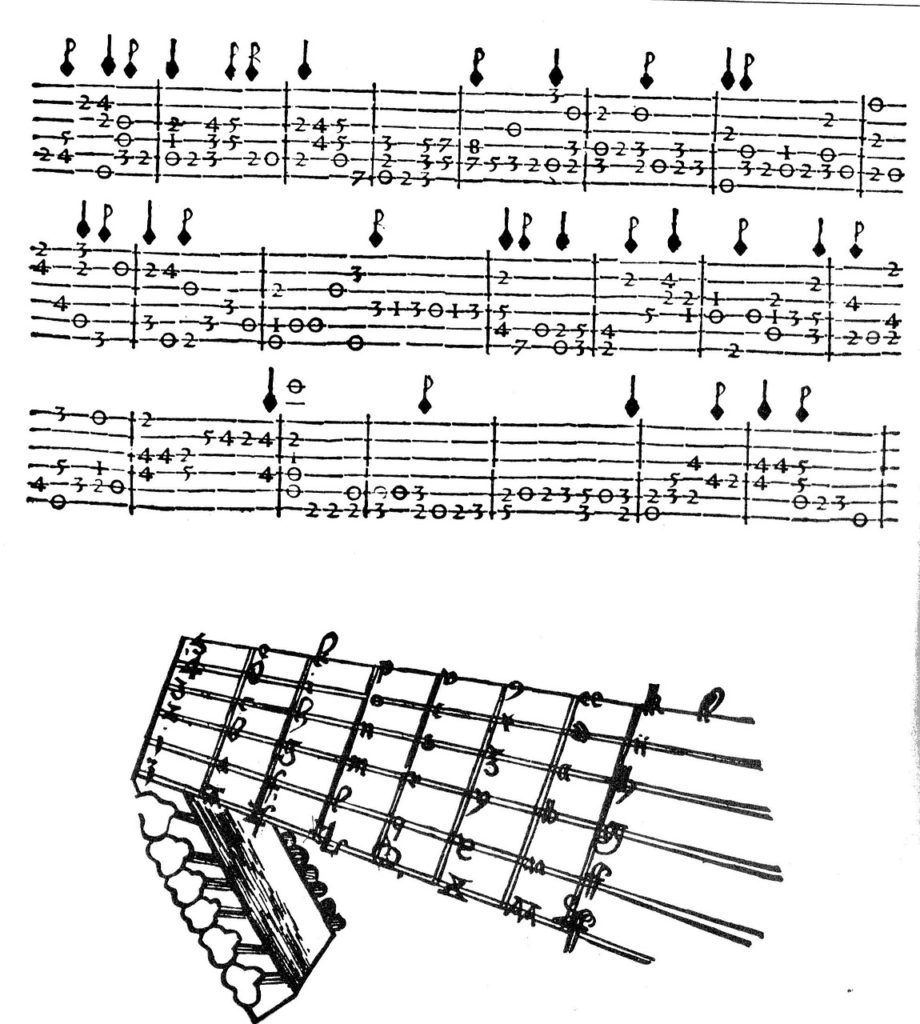
Some people react to the use of tablature as if there is something morally wrong with it (i.e. cheating, lazy, shifty … not the ‘right’ way). Tablature is actually the ORIGINAL system of notation for fretted instruments and dates back to the Renaissance with the lute family of instruments. Staff notation came MUCH later to these instruments … and I suspect because of lazy composers who wanted to write for the instruments, but didn’t want to bother with learning the intricacies of playing them (I could be wrong, that’s just a wild guess).
In many ways, tablature makes a LOT more sense as a notation system for fretted instruments, as there are often 3 or more choices for where and how you can play a phrase of music on the fretboard. It is NOT like a piano (or most winds), where you only have one key on the keyboard that will play that one single note on the staff. You have choices on stringed instruments. If you’ve really thought it through and come up with the most efficient way to play a piece of music, then tablature is the clear winner for passing this information on to others.
Does this mean to say I’m against staff notation? NO, by no means. I think the ideal notation for fretted instruments is a linked staff and tab … This allows you to see how the music relates to the melody and harmony through the staff notation as well as giving the best way to play it. Pianists do a similar thing by marking up their music with fingerings to remind them the best way to play a phrase; using tablature is no different.
The Addams Family Theme – Song of the Month Club Tutorial
- Addams Family Theme Sheet Music on Sheet Music Plus
Visit https://www.patreon.com/uke for Song of the Month Club member exclusives:
- Video covering additional chord inversions
- Video covering additional strums
- Video covering additional fingerpicking
- Video covering the instrumental tab (for those that would rather play than sing)
- Video and MP3 ‘click track’ to practice along with and/or record with.
- An invitation to participate in a music video of the song that will be released in October before Halloween. What better way to say ‘Trick or Treat’ to friends and family?
Help Choose the Song of the Month Club’s Halloween-Themed Song for September (October release)
Please visit this form at https://forms.gle/KquS8ujTvxDpHRFE7 to cast your vote for our first Song of the Month Club on a Halloween theme.
Uke & Me (aka M. Ryan Taylor) is hosting a song of the month club beginning in September. Ryan will produce tutorials for the song which will be freely available to all through his YouTube Channel …
Patrons who join the Song of the Month club at http://patreon.com/uke will have the option of participating in a group music video (similar to the virtual choir videos you’ve probably seen floating around on the web). Singers, strummers, singing strummers and instrumental players are all welcome to participate. You will need to record a video (most phones and cameras will work fine), while listening to a ‘click’ track, so that all the videos will be synchronized when put together.
Help choose our song for September (released in October). You will get updates from Uke & Me and may unsubscribe at any time.
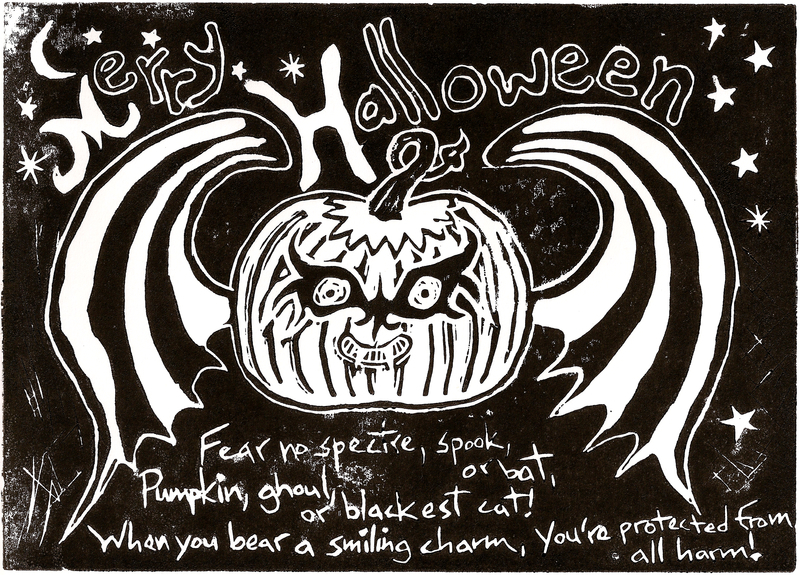
NEW Song of the Month Club

Hey! Beginning September of 2020, I’ll be starting up a new SONG OF THE MONTH CLUB. I’ll introduce a new song, with tutorials on the various parts … these will be available to everyone … any extra accompanying PDFs will be available to patrons at any tier on the Uke & Me patreon member site.
‘Song of the Month Club’ patrons who’d like to participate in making a video of the song can practice up and send in a video of the part they choose to do (videos made on your phone will work fine). I’ll compile the submitted videos into a whole, for a combined video to distribute to family and friends.
Check out the full details of our upcoming Halloween, Thanksgiving and Christmas themes at https://www.patreon.com/posts/song-of-month-40605656
The “I Want Uke” Uncle Sam T-shirt is Back!
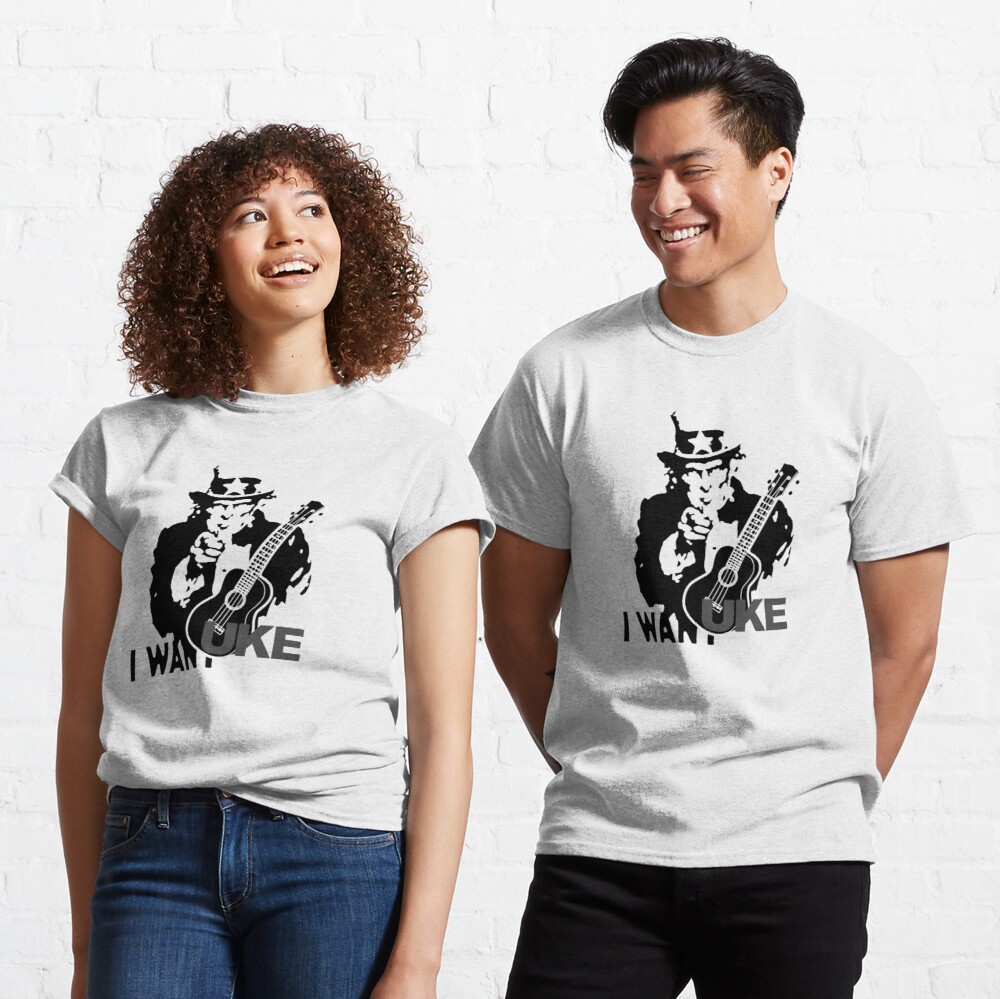
I created the I WANT UKE Uncle Sam tee design for one of my past festivals. The t-shirt is once again available via Redbubble, except now you can get more than a shirt … There are:
Enjoy! And remember: Uke are awesome!
Fun Finds: THE HUG STRAP
Don’t want to drill into your beautiful ukulele? Give it a HUG instead. No strap buttons, no problem!
Get THE HUG STRAP at http://bit.ly/2Cg7Imt
The Lion Sleeps Tonight : The Tokens Cover by Uke & Me
I created this little arrangement of The Lion Sleeps Tonight for a sing-a-long / recording session at the park next week, but thought I’d go ahead and record it as a reference for anyone coming who wanted to get a head start on it. It turned out well-enough that I decided to feature it as a video single on my YouTube channel. I only had one afternoon’s time to work on this between other commitments. Anyway, hope you enjoy it. Let me know in the comments if there are other songs you’d like to hear me cover! 🙂
Gear used in the video:
- Sony A6600 Camera: https://amzn.to/31JLXWO
- Soprano Ocarina: https://amzn.to/2ZBkrrQ
- Lanikai Tenor Ukulele: https://amzn.to/2NRvtE7
- Large-Diaphragm Condenser Microphone : https://amzn.to/3eYIxmL
- Mic Shield: https://amzn.to/3gp1gbz
- Pop Filter: https://amzn.to/3eY9lUf
- Mic Stand: https://amzn.to/3eYDpPA
- Mic Cable: https://amzn.to/3eYDuTo
- Sound Card – MOTU M4 4×4 USB-C Audio Interface: https://amzn.to/2VZamUT
- Softbox Lighting: https://amzn.to/31OhHtM
- OBS Studio (free): https://obsproject.com/
- Sony Vegas Video Editing Software: https://amzn.to/38nyJAm
Support more creative work like this at http://patreon.com/uke
Fun Finds: Quilted Ukulele Strap from Quilts & Ukuleles
- Check out a wide variety of styles at QuiltsandUkuleles on Etsy for these extremely comfortable ukulele straps.
New Camp Song Tutorials this Week – Old Ark’s a Moverin’ and One Bottle of Pop
Utah County: The Lion Sleeps Tonight … Ukulele Summer Session #1 for Youth & Adults
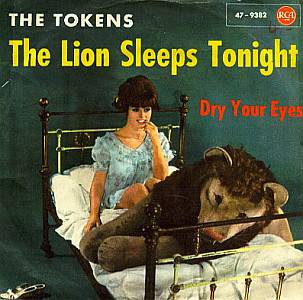
Please join us for our first Ukulele Summer Session where we’ll follow a format similar to Choir!Choir!Choir! – learning one song and then making a video that you can share with family and friends online. This next Wednesday our selection will be The Lion Sleeps Tonight.
- The Lion Sleeps Tonight Sheet Music
- Demo Music Video of The Lion Sleeps Tonight with Ryan singing and playing all the parts (in case you’d like to practice ahead).
- RSVP – Please let us know if you are coming, as we need to limit our numbers to 50 people. Thank you!
Because of this one-rehearsal and then go format, you can expect that there will not be anything too difficult in the Ukulele Summer Session – this first song has just 3 chords: F, Bbadd9 & C (2013, 3213 & 0003 fret numbers). Non-singers are welcome to strum, fingerpick and tab. Non-players are welcome to come and just sing. If you do both, you’ll be welcome to show off your skills. 🙂
- Date: Wednesday, July 8th
- Time: 6:30 – 8 pm
- Location: Quail Cove Park, American Fork UT – Across the street from the Mt. Timpanogos Temple. There is plenty of room for social distancing between family groups.
- Suggested Tip: $5 for individuals, $10 for families for each evening (cash, check or paypal) or subscribe at https://www.patreon.com/uke for additional online content.
- Bring your Own: Ukulele, Lawn Chairs, Music Stands, Printed Music (see link above), Music Clips (in case of wind).
- Difficulty: There will be easy chords for beginners and inversions for intermediate+ players. Singing will consist of unison, 2-part and 3-part harmony.
Fun Finds: Learn the Ukulele Fretboard with Fantastic Finger Guides Stickers
My review of ukulele fretboard stickers by Fantastic Finger Guides. In summary:
- Nice design – love the simple dots for sharps and flats, as opposed to trying to fit ‘G#/Ab’ into a space.
- Easy install – attach the sticker to a credit card, guide it under the strings and press it down, wrapping it around the neck.
- Includes fret numbers on the side.
- Includes GCEA sticker for just below the nut.
- Designed to be temporary.
- Great reference for students to learn the fretboard.
Update! Toby from Fantastic Finger Guides sent me an answer to my question about the different colors: “To answer your question about color scheme. I chose 2 colors so that it would break up the finger guide for the student. That way they could more easily see where the 6th fret starts using color coding. Also I spent time with an interior designer that knows colors to make sure the colors matched well with the wood tones of the ukulele.”
Win a Fantastic Finger Guide for Your Ukulele
Join the Uke & Me newsletter for ukulele video tutorials, reviews, art, performances, fun finds & more before August 1st, 2020, and you’ll be automatically entered to win an ukulele fretboard sticker by Fantastic Finger Guides, as well as other prizes (including the Rocket Man Sticker Bomb ukulele featured in the video).
3-Part Series on Understanding Chords now Complete
I set out to do a three-part series on ‘understanding chords’ (link to YouTube playlist … links to transcripts on this page below the videos) and got it done in time for the annual Utah Uke Fest, which was held virtually this year. Here are all three videos …
Here are links to the transcripts from each of the videos:
- Top 5 Tips to Avoid Chord Overwhelm
- Can We Demystify Chords in 7 Steps?
- 10 Ways Satisfying Melodies Interact with Chords (with Examples Taken from Popular Tunes)
Subscribe to my YouTube Channel and click the Bell icon to get notices when new videos are released.
Ukulele Sticker Bomb : Rocket Man Edition
I’d been wanting to try out doing a ‘sticker bomb’ ukulele. I’m planning to give this ukulele away as part of my Ukes of Summer giveaway. Stay tuned for details (make sure you’re subscribed to the blog – see the right-hand column).
Cute Kids Sing “You Are My Sunshine” on Ukes in Harmony
One of the performances submitted for the Utah Uke Fest this year (a couple of my Ukulele Youth students). This was my favorite performance of the year …
